Kosovo and Metohija represented, in the medieval ages, the center of
the Serbian State and of the spiritual and cultural life of the Serbian people. Prizren
was the Capital City of a number of kings and emperors, and Pec was the seat of the
Serbian Patriarchate, proclaimed in 1346.
At Kosmet, there are almost two hundred churches and monasteries from
that period (14th century). The most important among them are: The Church of the Holy
Virgin Ljeviska, 1307, in Prizren, the Church of the Saint Archangels near Prishtina, the
monasteries Visoki Decani, Gracanica, Banjska. The complex of the Serbian Patriarchate,
consisting of a number of churches is situated in Pec; the most important among them are
the Church of the Saint Apostles (1253) and the Church of Saint Demetrios (1324).
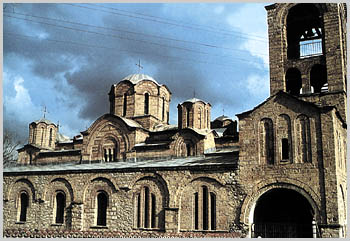
The Church of the Holy
Virgin Ljeviska in Prizren, 14th century
Among the architectural monuments of the Turkish era, the most
important are: the Fatih Mosque in Prishtina, the Sinan Pasha Mosque in Prizren, the Hadum
Mosque in Djakovica, the Bajrakli Mosque in Pec, the Grave of the Sultan Murad and the
Grave at Gazimestan.
In Kosmet, over 250 immovable cultural-historical monuments are
protected by the state.
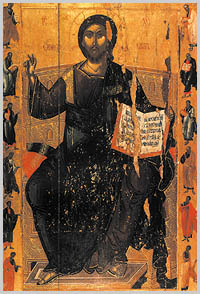
The Decani Monastery - The Icon of Christ Pantocrator, 16th century
The first manuscript books were created and the first libraries were
established in those churches. There are over 400 libraries in the Province, with some 3
million books. The University Library in Prishtina has 360.000 books, three thousand being
rare and ancient.
Painting was also developed mainly in the churches, and mainly as
fresco painting. The oldest and greatest paintings are situated in the Church of the Saint
Apostles in Pec (around 1260). The most important fresco paintings from the medieval ages
are those in the monasteries of the Holy Virgin Ljeviska, Gracanica and Decani.
The bases of the popular oral literature started also during that time
period, primarily the heroic ballads about the personalities and the historical events,
for example about the Kosovo Battle in 1389.
Modern cultural institutions were established in Kosovo and Metohija
after the Second World War: the National Theater of the Province, with Serbian and
Albanian drama and ballet, the national Theater in Djakovica, the Kosovo Museum, the
Kosovo Archives, the National and University Library, the Film Production House
"Kosovo Film", the Cultural center of the Province, The Gallery of Art, the Folk
Dance Group "Shota", "Venac", etc.
There exist, in Kosovo and Metohija over 370 amateur associations for
art and culture, with several thousands active members. Amateur theaters exist in bigger
places. The actors are educated at the Faculty of Dramatic Arts in Prishtina.
The Musical Art started also as Orthodox sacred music, and there exist
scores - records of that music created by medieval composers. After the fall of the
Serbian State, between the 15th and 19th centuries, the singing with gusle accompaniment
was developed. Since the 19th century, the authors’ musical creativity started to
develop. There are over 70 various festivals in the Province, at which the professional
and amateur creativity of all nations and national communities are presented.
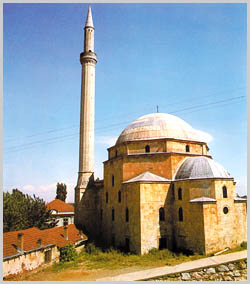
The Sinan-Pasha Mosque in
Prizren, covered by lead taken from the Orthodox monastery Archangel
THE APPEAL OF FRANC WEBER FOR
THE PRESERVATION OF THE
CULTURAL
HERITAGE OF KOSMET
The ecologist of world renown, Franc Weber launched, by the beginning
of october, 1998, an SOS appeal for help to the leaders of the Great Powers, including the
French President Jacques Chirac, in which he invited them "on behalf of civilized
Europe" to prevent the "barbarian act" of bombing Kosovo and Metohija and
to protect the cultural heritage of that southern Serbian province.
Weber, who is struggling during the last 30 years for the salvation of
the natural and cultural-historical heritage all over the world, addressed the appeal
against the possible air intervention of NATO at Kosmet to the American President Clinton,
to the Russian President Yeltzin, to the French President Chirac, to the British Prime
Minister Blair, to the leaving German Chancellor Kohl, to the Chinese President Djian
Cemin and to the Italian Prime Minister Prodi. In his letter to the French President
Chirac, entitled "NATO endangers the European cultural heritage in Kosovo",
Weber reminds him that Kosmet, with 1800 Serbian-Byzantine medieval monuments, including
the "beauties of architecture and art" like the Pec Patriarchate and Decani,
represent "one of the biggest and most dense historical and cultural sites in the
world".
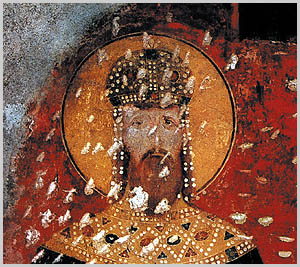
The Holy Virgin Ljeviska -
King Milutin, fresco painting, 1310-1313
MAP OF CULTURAL HISTORICAL MONUMENTS
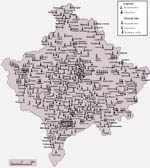
Map of cultural-historical
monuments in Kosovo and Metohija
THE HIGHEST CONCENTRATION
OF CULTURAL AND HISTORICAL MONUMENTS IN THE WORLD
Eminent fighter for the protection of the world heritage, Weber
invites, in his letter to President Chirac, the Head of the French Republic to do
everything possible, "on behalf of civilized Europe" to prevent the
"barbarian act" of the possible air strikes in Kosmet.
"It is a fact that the bombing would mean, with the excuse of the
prevention of humanitarian catastrophe, the endangering, if not the destruction of the
cultural heritage of Kosovo", Weber says, warning also about the danger of
"innumerable civilian victims" and the noxious consequences to the environment
and the health of the population, as it happened in Bosnia after the NATO bombings."
‘Civilized Europe can not understand such an external interference
into an internal conflict in a sovereign country", Weber explicitly states, and
underlines that the "humanitarian catastrophe in Kosovo can not be solved by fire and
bloodshed in that province", i. e. that the conflict between Serbs and Albanians
"can not be solved by bombing one side for the profit of the other."
Franc Weber visited, with a group of foreign journalists, Kosovo and
Metohija, in June, and then addressed to the General Director of UNESCO, Federico Mayor,
and to 626 deputies in the European Parliament individually, an appeal to grant to the
cultural-historical monuments in Kosovo the status of world heritage. In that move for the
peace in the Balkans, he assessed that the "granting of the status of world cultural
heritage" could help "Serbs and Albanians, Christians and Moslems, to overcome
the antagonisms of the past and to work on their reconciliation".
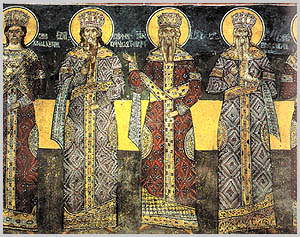
The Patriarchate of Pec -
The House of Nemanjici, fresco painting
THE MONUMENTS OF EXCEPTIONAL IMPORTANCE
IN KOSOVO AND METOHIA
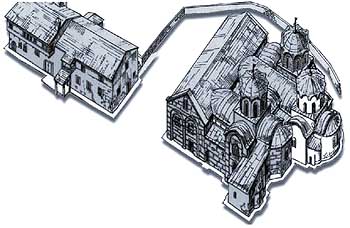
The Pec Patriarchate, a part of the Monastery
Complex
Pec:
The Pec Patriarchate, the Bajrakli Mosque
Decani:
The Decani Monastery (Locane), the Log cabin of the Danilovici
Pristina:
The Gracanica Monastery, Gazimestan - complex of monuments, Imperial Mosque, Ulpiana
Prizren:
The Holy Virgin Ljeviska Church, the Sinan Pasha Mosque, the Kaljaja Fortress, the Turkish
Bath, The Saint Nicholas’ Church, the Church of Saint Savior, The Monastery of the
Holy Archangels (Bogosevci), The Saint Nicholas’ Church (Drajcici), the Saint
Nicholas’ Church (Gornje Selo), the Saint George Church (Korisa), the Monastery and
the Hermit’s Cell of Saint Peter Koriski (Musnikovo), the Church of the Holy
Apostles, the Church of Saint Nicholas (Sredska) the Church of the Holy Virgin, the Church
of Saint George.
Orahovac:
Velika Hoca (an entire village with 13 Christian churches), The Church of Saint John, the
Church of Saint Nicholas
Suva Reka:
Musutiste, The Church of the Holy Virgin Odigitria (Recane), the Church of Saint George
Zvecan:
the Banjska monastery, the Zvecan Fortress, the Sokolica Monastery
Istok:
the Church of the Holy Virgin Hvostanska, the Gorioc Monastery (Istok), the Church of
Saint Nicholas (Durakovac), the Church of Saint John (Crkolez)
Vucitrn:
the Vojnovica Bridge, the Castle-Fortress
Klina:
the Church of the Transfiguration of Christ (Budisavci), the Saint Peter and Saint Paul
Monastery (Dobra Voda), the Church of the Presentation of the Holy Virgin (Dolac), The
Church of Saint Petka (Drsnik), the Church of Saint Nicholas (Kijevo), the Church of Saint
Nicholas (Mlecane), Gornja Crkva, the Church of the Saints Cosma and Damian (Cabici), the
Church of Saint Nicholas
Kosovska
Kamenica: the Church of the Holy Virgin (Vaganes), the Ubozac Monastery
Gnjilane:
the Saint Barbara Church
Srbica:
the Devic Monastery
Novo Brdo:
the Novo Brdo Fortress
Lipljan:
the Church of the Presentation of the Holy Virgin
Djakovica:
The Terzijski Bridge, the Hadim Mosque
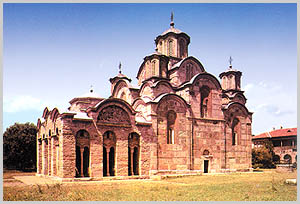
The Gracanica Monastery,
14th century